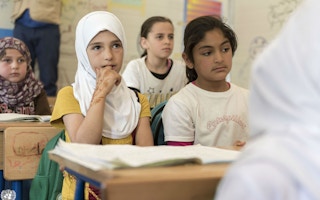Around the world, some 250 million children are unable to attend school, and many who do have access to a classroom are not learning the skills they need to succeed in life. And, despite a growing consensus about the systemic nature of the challenges affecting education, there is less agreement about how address those systemic challenges.
To continue reading, subscribe to Eco‑Business.
There's something for everyone. We offer a range of subscription plans.
- Access our stories and receive our Insights Weekly newsletter with the free EB Member plan.
- Unlock unlimited access to our content and archive with EB Circle.
- Publish your content with EB Premium.
Yet 2018 is shaping up to be a promising year for global efforts to improve educational access and quality.
One reason is the emergence of so-called peer action networks, which facilitate knowledge-sharing globally and encourage continuous improvement locally. Such networks, if organized properly, could offer a partial solution to the systemic challenges affecting education.
There are numerous peer groups tackling some of the planet’s most difficult problems, but two that are associated with our organizations are worth highlighting. One is the Joint Learning Network for Universal Health Coverage (JLN), a community of practitioners and policymakers from 30 countries supported by Results for Development and other development partners.
The other is the Asia Society’s Global Cities Education Network (GCEN), which facilitates improvements in urban education systems throughout North America and Asia.
Each of these international peer networks has produced local results. For example, in 2016, Denver Public Schools in Colorado – a GCEN member – created the CareerConnect program, which provides workplace-based learning opportunities for students. The program draws on lessons from vocational education systems in Hong Kong, Melbourne, and Singapore – all GCEN member cities – as well as Switzerland, to help graduates prepare for life after high school.
Similarly, the JLN has made significant progress helping developing countries move toward universal health coverage. Network support has enabled members to navigate technical roadblocks and secure political support at home. Adapting the JLN model to support officials of national education ministries could produce comparable gains in education in many countries.
Both of these networks offer a global platform for local practitioners to devise solutions and drive innovation. And both are organized around five principles that we believe successful peer groups – in education or any sector – should strive to incorporate into their own work.
“
When like-minded policymakers and practitioners share ideas and collaborate on solutions, the world’s educational challenges become a little less daunting.
First, networks bring together leaders who are facing similar issues in varying contexts. International peer action networks are most effective when they are cross-cultural; we have found that connecting disparate groups that are working toward similar goals often produces unexpected solutions that are more robust.
Second, the “peer” component of these networks is strongly emphasized. Members are equally empowered to set priorities and contribute to discussions. Networked learning is most successful when participants feel a sense of ownership with respect to outcomes.
Third, membership includes those with the authority and the ability to influence change. For example, many challenges at the national or city level in education planning require both political and technical solutions. For a network to be effective, policymakers and practitioners must work in concert to find solutions to shared challenges.
Fourth, the JLN and the GCEN are committed to measuring collective and individual progress. While gauging success in education can be difficult, especially across contexts, peer action networks must be oriented toward achieving results, and that means measuring their effectiveness. Moreover, accountability metrics should be derived from systems that members are already using at home.
Finally, these networks strive to be sustainable. To drive large-scale and lasting change through a network in any sector, but especially in global education, requires consistent vision, staffing, and financial resources. Peer group participants cannot simultaneously work as policymakers or practitioners and collaboratively run a network organization. Budgeting for central teams to manage the technical support to members and operations of the network is critical to success.
Unfortunately, very little education funding is currently set aside for investments in new learning networks. Increasing investment in peer action networks could help to bolster leadership and implementation capacity – critical to expand learning opportunities around the world, a key objective of the United Nations Sustainable Development Goals.
There are no easy solutions to providing high-quality education to every child on the planet. However, as the growth in peer action networks demonstrates, global education leaders are not in this struggle alone. When like-minded policymakers and practitioners share ideas and collaborate on solutions, the world’s educational challenges become a little less daunting.
Amy Black is a senior fellow at Results for Development. Alexis Menten is Executive Director for Program Development at the Center for Global Education at Asia Society.
Copyright: Project Syndicate, 2018.
www.project-syndicate.org










